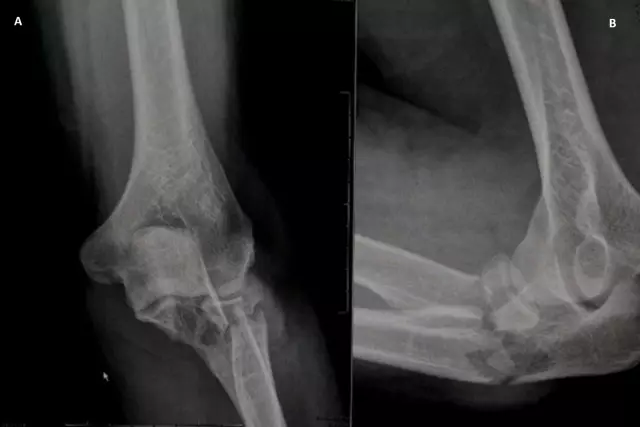- Author Rachel Wainwright [email protected].
- Public 2023-12-15 07:39.
- Last modified 2025-11-02 20:14.
Coccyx
Coccyx. general information
The tailbone or coccyx (lat.) Is the final part of the human spine. It distinguishes 4 or 5 (in some cases) vertebrae, the size of which decreases from top to bottom, which determines the triangular shape of the coccyx. With its wide base, the tailbone is connected to the sacrum, its top is directed downward.

On the 1st coccygeal vertebra, the presence of a vertebral body can be noted, horns in the amount of 2 pieces and transverse processes are hardly distinguishable. In some cases, transverse processes can also be distinguished in vertebra II, while the rest of the vertebrae are rudimentary bodies of cancellous bone substance.
In old age, all the coccygeal vertebrae, except for I, grow together. More often this phenomenon is observed in men.
A thin coccygeal muscle is attached to the tailbone. It is paired, rectangular in shape. The muscle extends from the ischium to the lateral edges of the upper coccygeal and lower sacral vertebrae. Where, intertwining with the fibers of the posterior bundles, provides mobility of the pelvic diaphragm.
The coccygeal plexus, which gives rise to the anal-coccygeal nerves, is located at the beginning of the coccygeal muscle.
The blood supply to the tailbone is carried out thanks to the middle sacral artery and its branches. The outflow of blood occurs through the co-named vein.
Coccyx functions
Despite the fact that the tailbone is a rudimentary organ, it performs quite important functions in the body:
- Its anterior sections are the site of attachment of the ligaments and muscles involved in the functioning of the distal intestines and organs of the genitourinary system. In addition, some muscle bundles of the gluteus maximus muscle, a powerful hip extensor, are attached to the tailbone;
- The coccyx is involved in the distribution of physical load on the anatomical structures of the pelvis, and also serves as a fulcrum when bending back.
Coccyx injury
The most common tailbone injuries are bruises and fractures:
- Coccyx injury is called damage to the surrounding soft tissues. This is a lung injury. Most often occurs as a result of a fall. First of all, with a bruise, patients complain that the tailbone hurts. If a fall causes pain, see a doctor immediately, as the consequences of injury can be serious, even though the pain may subside several hours after injury. Quite often, a tailbone injury becomes chronic without proper treatment. In this case, the pain may occur unexpectedly, causing discomfort, and just as suddenly disappear for several weeks or even months. A bruise symptom can also be an indicator of a bruised tailbone. A patient with a similar injury is recommended to bed rest and the exclusion of physical activity in any form. Sitting is also strictly not recommended, however, in extreme cases, when sitting, a special orthopedic pillow, which is a rubber circle, can be used.
- Fracture of the tailbone occurs when falls on the buttocks, as a result of strong mechanical impact, in case of damage as a result of a traffic accident. Most often, fractures are observed in women, which is due to anatomical differences in the structure of the pelvis of both sexes, as well as in the elderly. Coccyx fractures can be either with or without displacement. Most often, however, not even a fracture is observed, but a fracture-dislocation. Symptoms of fracture and dislocation are quite similar. Patients also complain that the tailbone hurts, and the pain becomes more intense while walking, with sudden movements and coughing. Sitting in the correct position is difficult, swelling is often observed in the affected area, and problems with defecation are likely. External palpation reveals the pathological mobility of the coccyx. An accurate diagnosis can only be made based on the results of an X-ray examination. Treatment of a tailbone fracture involves the application of a special splint, which is a cotton-gauze circle. The period of wearing the splint (at least two weeks) should be accompanied by rest, bed rest is recommended. In some cases, pain medications are prescribed. In order to help the body to cope with the fracture faster, it is recommended to take medications containing calcium, vitamins and collagen. Special physiotherapy exercises will also be helpful. In cases where the fusion of the bone is difficult, they resort to surgical intervention. The period of wearing the splint (at least two weeks) should be accompanied by rest, bed rest is recommended. In some cases, pain medications are prescribed. In order to help the body heal the fracture faster, it is recommended to take medications containing calcium, vitamins and collagen. Special physiotherapy exercises will also be helpful. In cases where the fusion of the bone is difficult, they resort to surgical intervention. The period of wearing the splint (at least two weeks) should be accompanied by rest, bed rest is recommended. In some cases, pain medications are prescribed. In order to help the body heal the fracture faster, it is recommended to take medications containing calcium, vitamins and collagen. Special physiotherapy exercises will also be useful. In cases where bone fusion is difficult, they resort to surgical intervention.
Found a mistake in the text? Select it and press Ctrl + Enter.






